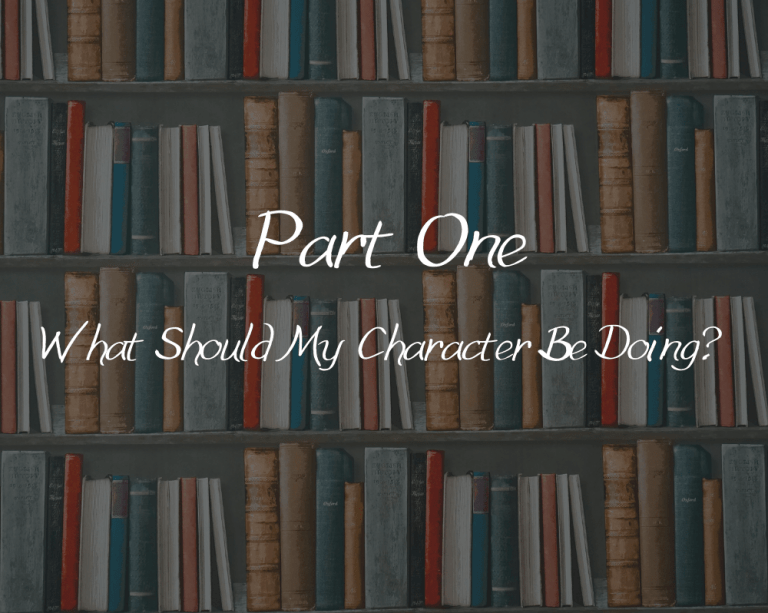

{A note from Alyson: all the strategies and rules of this blog series apply primarily to adventure novels. Not all standards and regulations will carry into other genres.}
“I know how to write, and I’m good at it. I know my character, and he’s great. If only I knew just what he ought to do, that people would like to read his story, then I should get started soon.”
Creating a character is the best part of writing, but figuring out what to do with him? Well, that can get sticky. We often envision our hero doing something in the middle of the book, but we have no clue what he should do initially. How do we introduce our character in a captivating way?
In general, your hero can either be doing something positive or negative. For example, your hero can either be meeting up with his friends at the skate park (positive) or going on a long walk alone (negative). The positives are always something your hero enjoys, regularly does, or involves other people. The negatives are always something the hero dislikes, isn’t sure about, or leaves him alone. Let’s take these ideas separately for a moment.
Positive
I slapped the snooze button and rolled out of bed. Seven-thirty. I had ten minutes to make it. Pulling on a pair of jeans and a green T-shirt, I then rushed downstairs to catch Mom shoving blueberry cobbler on two plates. She topped the cobbler with whipped cream, and we sat down for Saturday breakfast. We hurried through, not talking but smiling nonetheless.
Then, Mom rose, grabbed her purse and car keys, and turned to me. “Remember, I’ll be back at…”
“Six-thirty sharp,” I finished. Mom nodded and left. {1}
This is positive: it is something the hero likes, something he regularly does, and involves another person. How do we know this is the hero’s typical day? Because he knew what to expect, when to expect it, and could even finish his mother’s sentence. It implies that they’ve been through this Saturday many times before. Positives usually leave your readers feeling happy. However, positives often leave the writer with the question: “what am I supposed to do next?”
Negative
The streets of Venirum were foreboding this time of night. I didn’t want to look into the darkened side streets, but my eyes kept glancing all around as I walked the paved road. I wasn’t sure when the messenger from Beyond would show. I felt the need to both hurry and slow down. At last, I left the road and stepped into the parking lot in front of the church. For some reason, I felt better standing there.
Then, a voice spoke. “Vaughn.” {2}
We can tell this is negative because our hero is nervous, unsure of what he’s doing, and he is alone. Negatives are desirable over positives because they launch into a hero’s struggle immediately. However, negatives lend themselves to being too negative, and the writer must stumble around to find the right balance between negative and too-much-negative.
Both positives and negatives have obstacles for the writer to overcome. So, writers combine them to get the best of both positive and negative, like a battery. We combine one negative charge with one positive charge and create a current that our readers will love!
Positive-Negative Current
Devora couldn’t bear it if he saw her. Not today. She was too ashamed to meet him. So, Devora skirted Right Street and took the back alley instead. She pushed the iron door, and a whoosh of cold air blew her dark hair. Devora scanned the checkered tables and found her friends sitting at the one right underneath the sign, which read “Ivan’s Ice Cream Parlor.”
“Devora, over here!” her friends called. “You’re late for the first time in three weeks. What happened?”{3}
How do we know that Devora goes here frequently? Because she knows multiple ways to get there, and her friends imply that she’s been there three weeks in a row. It is a habit for the heroine. So, we have a positive {something enjoyable, something routine, and people}. Yet, the first part implies that something unusual is also happening: she’s not taking the usual route to the ice cream parlor. So, we have a negative {something the character dislikes and is unsure about}.
This is a positive-negative current. You could also call it a negative-positive current because you can put either the positive or negative first. The idea is that they are meshed together or come one after another. Your hero could start doing something everyday, and then it turns into something unexpected. Or, your hero could begin in abnormal circumstances and then be brought back to a calm normal. Or, your hero could start by doing something typical in an unusual way. It all flows {pun intended}!
You just have to know your character {his likes, dislikes, routine, habits, fears, etc.} and where he is to determine what he ought to do. Don’t stress yourself out trying to think of endless possibilities. Follow the pattern that so many other people who write use to interest those who read, and then you only have to write a couple of ideas.
So, what will your character be doing?
Footnotes: